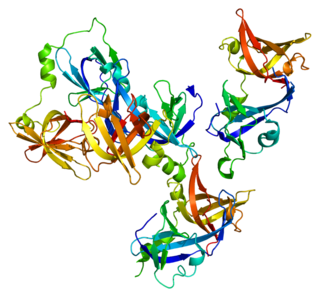
p73 is a protein related to the p53 tumor protein. Because of its structural resemblance to p53, it has also been considered a tumor suppressor. It is involved in cell cycle regulation, and induction of apoptosis. Like p53, p73 is characterized by the presence of different isoforms of the protein. This is explained by splice variants, and an alternative promoter in the DNA sequence.

DnaJ homolog subfamily A member 3, mitochondrial, also known as Tumorous imaginal disc 1 (TID1), is a protein that in humans is encoded by the DNAJA3 gene on chromosome 16. This protein belongs to the DNAJ/Hsp40 protein family, which is known for binding and activating Hsp70 chaperone proteins to perform protein folding, degradation, and complex assembly. As a mitochondrial protein, it is involved in maintaining membrane potential and mitochondrial DNA (mtDNA) integrity, as well as cellular processes such as cell movement, growth, and death. Furthermore, it is associated with a broad range of diseases, including neurodegenerative diseases, inflammatory diseases, and cancers.

Bcl-2-like protein 11, commonly called BIM, is a protein that in humans is encoded by the BCL2L11 gene.

DNA damage-inducible transcript 3, also known as C/EBP homologous protein (CHOP), is a pro-apoptotic transcription factor that is encoded by the DDIT3 gene. It is a member of the CCAAT/enhancer-binding protein (C/EBP) family of DNA-binding transcription factors. The protein functions as a dominant-negative inhibitor by forming heterodimers with other C/EBP members, preventing their DNA binding activity. The protein is implicated in adipogenesis and erythropoiesis and has an important role in the cell's stress response.

Apoptosis-stimulating of p53 protein 2 (ASPP2) also known as Bcl2-binding protein (Bbp) and tumor suppressor p53-binding protein 2 (p53BP2) is a protein that in humans is encoded by the TP53BP2 gene. Multiple transcript variants encoding different isoforms have been found for this gene.

Bcl-2-interacting killer is a protein that in humans is encoded by the BIK gene.

Gamma-interferon-inducible protein Ifi-16 (Ifi-16) also known as interferon-inducible myeloid differentiation transcriptional activator is a protein that in humans is encoded by the IFI16 gene.

Tribbles homolog 3 is a protein that in humans is encoded by the TRIB3 gene.

Baculoviral IAP repeat-containing protein 7 is a protein that in humans is encoded by the BIRC7 gene.

Apoptosis regulatory protein Siva is a protein that in humans is encoded by the SIVA1 gene. This gene encodes a protein with an important role in the apoptotic pathway induced by the CD27 antigen, a member of the tumor necrosis factor receptor (TFNR) superfamily. The CD27 antigen cytoplasmic tail binds to the N-terminus of this protein. Two alternatively spliced transcript variants encoding distinct proteins have been described.

RelA-associated inhibitor is a protein that in humans is encoded by the PPP1R13L gene.

BCL2/adenovirus E1B 19 kDa protein-interacting protein 3-like is a protein that in humans is encoded by the BNIP3L gene.

Leucine-rich repeats and death domain containing, also known as LRDD or p53-induced protein with a death domain (PIDD), is a protein which in humans is encoded by the LRDD gene.

Apoptosis facilitator Bcl-2-like protein 14 is a protein that in humans is encoded by the BCL2L14 gene.

Death effector domain containing protein is a protein that in humans is encoded by the DEDD gene.

Inhibitor of growth protein 3 is a protein that in humans is encoded by the ING3 gene.

Putative quinone oxidoreductase is an enzyme that in humans is encoded by the TP53I3 gene.

Tumor protein p53-inducible nuclear protein 1 is a protein that in humans is encoded by the TP53INP1 gene. In mice this protein is also called TRP53INP1 and is encoded by the Trp53inp1 gene. The protein is also referred to as SIP or "stress inducible protein"

Apoptosis-inducing factor 2 (AIFM2), also known as apoptosis-inducing factor-homologous mitochondrion-associated inducer of death (AMID), is a protein that in humans is encoded by the AIFM2 gene, also known as p53-responsive gene 3 (PRG3), on chromosome 10.

Tumor protein p53-inducible protein 11 is a protein that in humans is encoded by the TP53I11 gene.






















